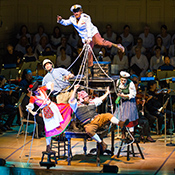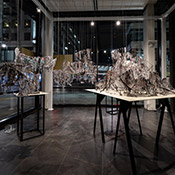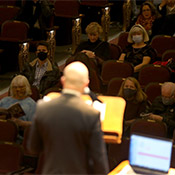
Converging Landscapes Combines Music with Visual Arts
David Lewellen
PUBLISHED
Tagged Under: 2021.22 Season, Guest Artist, Violin
The crash of the Pacific Ocean into the cliffs of Big Sur is a long way from the shores of Lake Michigan. But this week’s Milwaukee Symphony performance of John Adams’ “The Dharma at Big Sur” will have plenty of local connections for soloist Tracy Silverman.
Silverman, a pioneer on the six-string electric violin, grew up in Beloit, and every week his parents would drive him to Chicago for lessons with Debbra Schwartz – the mother of current MSO violinist Margot Schwartz.
But after his conventional training on the conventional instrument, Silverman quickly gravitated to playing electric violin in jazz and rock settings. And one night in 2002, Debbra Schwartz took John Adams to a club in Berkeley, Calif., to hear her former student play. Adams liked what he heard so much that “The Dharma at Big Sur,” which was already in the process of composition, became a concerto for electric violin and orchestra.
The Los Angeles Philharmonic premiered the piece in 2003 as part of the festivities to open Disney Concert Hall. But since then, “it’s become part of the canon, and it’s been performed by so many players,” Silverman said. “In 2003, I was one of the only people who even owned a six-string electric violin. But the piece is so good, classical violinists go out and buy electric violins just to play it.”
The six-string instrument that Silverman designed adds lower range but also allows it to “function exactly like a guitar does in a band, playing lead guitar or rhythm guitar. It fits the musical language of our time – jazz, rock and roll, hip-hop.” He has even developed a strum bowing technique to allow a violinist to play chords while singing – like a guitar.
But on the classical side, Silverman has also commissioned several other concertos for his instrument. “I think this is the future of strings,” he said. “We need to adapt and play the contemporary music that surrounds us.”
In program notes for his work, Adams wrote that in Silverman’s playing, like most musical cultures, “the real meaning of the music is between the notes,” and that his style “reminded me not only of the great jazz and rock performers … but it also made me think of the prose style of Jack Kerouac, so deeply influenced by his listening to the rhythms and melodic arcs of improvised jazz.”
Nevertheless, Silverman said, “There is not one tiny bit of improvisation anywhere in the piece, but it sounds improvised.” Adams even asked him to use a music stand, “so people don’t think you’re making it up.”
That is ironic, after Silverman has spent his career looking for the freedom to improvise, but “I’ve just come to accept that there are two different processes I’m involved in. One is performing, one is creating. Performing is storytelling. It’s [Adams’] music, but because it was written for me, it’s very natural for me to tell this story.”
Another way to tell that story is through images, and the MSO’s performance will also feature the work of video artist Adam Larsen. “I wanted the visuals to work with Adams’ music, so I didn’t feel like I had carte blanche,” Larsen said. “I had to find out what the music meant to me. It was an incredible process, and also difficult.”
He spent time filming the wild California coast of Big Sur, trying to capture “the feeling of standing on the edge of a really wild space.” He also used three dancers in composing his images, which helped give a sense of scale to the scenery.
Larsen originally created his video in 2018, to be played in a gallery along with a sound recording of Adams’ piece. For live performance, a technician follows the score and keeps the video aligned with the conductor’s tempo – not the other way around.
Perhaps because he has “spent a lot of time in dark theaters over the last 20 years,” Larson feels drawn to nature. For Adams’ music, he tried to create a visual narrative of rock, sky, water, trees, and the human body, “so that the audience doesn’t get bored. I look for things people have never seen before, like maybe certain colors on the water.”
Larsen studied film in college but was quickly attracted to designing video for live performance – first in theater and dance, and more recently in the concert hall. “The art of our era may be known for hybrids, interplay between mediums,” he said, and orchestras are interested in using visual elements to appeal to a younger audience.
He feels at home with collaborative work, considering the ideas of composers or stage directors. “Sometimes it’s nice not to have every option on the table,” he said. “I like to think about visuals while I’m listening to music, and how to present it in a way that the audience will feel similarly.”



